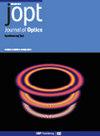An approach to generate cross-polarization modulation-enabled optical frequency comb with enhanced spectral flatness in traveling-wave semiconductor optical amplifiers
IF 2.7
4区 物理与天体物理
Q3 OPTICS
引用次数: 0
Abstract
This paper proposes a method for generating an optical frequency comb (OFC) using the cross-polarization modulation (XPolM) effect in a traveling-wave semiconductor optical amplifier (TW-SOA). The TW-SOA acted as a lumped amplifier, enabling pulse generation within the comb. The proposed method of OFC generation achieved a comb spectrum with 51 lines and a maximum power deviation of 1.8 dB, indicating excellent spectral flatness. The proposed approach effectively utilized XPolM in a TW-SOA to create broad flat OFCs. The effectiveness of XPolM depends on various SOA parameters, such as pump and signal powers, and the confinement factor. To understand the XPolM-enabled OFC behavior, various parameters, such as input polarization, bias current, SOA confinement factor, and carrier density, have been optimized. These parameters significantly influenced the generated comb spectrum. This study also provides valuable insights into optimizing comb characteristics through theoretical analysis. The proposed OFC generation was simulated using an OptiSystem simulator. This has paved the way for the potential use of the comb as a multichannel source in various optical devices.在行波半导体光放大器中生成具有增强光谱平坦性的交叉偏振调制光频率梳的方法
本文提出了一种利用行波半导体光放大器(TW-SOA)中的交叉偏振调制(XPolM)效应产生光频梳(OFC)的方法。TW-SOA 充当块状放大器,可在梳状器内产生脉冲。所提出的 OFC 生成方法实现了 51 条线的梳状光谱,最大功率偏差为 1.8 dB,显示出极佳的光谱平坦性。所提出的方法在 TW-SOA 中有效利用了 XPolM,从而产生了宽平的 OFC。XPolM 的有效性取决于各种 SOA 参数,如泵浦和信号功率以及约束因子。为了了解 XPolM 的 OFC 行为,对各种参数(如输入偏振、偏置电流、SOA 限制因子和载流子密度)进行了优化。这些参数对生成的梳状频谱有重大影响。这项研究还通过理论分析为优化梳状特性提供了宝贵的见解。使用 OptiSystem 模拟器对所提出的 OFC 生成进行了模拟。这为在各种光学设备中将梳状光谱用作多通道光源铺平了道路。
本文章由计算机程序翻译,如有差异,请以英文原文为准。
求助全文
约1分钟内获得全文
求助全文
来源期刊

Journal of Optics
OPTICS-
CiteScore
4.50
自引率
4.80%
发文量
237
审稿时长
1.9 months
期刊介绍:
Journal of Optics publishes new experimental and theoretical research across all areas of pure and applied optics, both modern and classical. Research areas are categorised as:
Nanophotonics and plasmonics
Metamaterials and structured photonic materials
Quantum photonics
Biophotonics
Light-matter interactions
Nonlinear and ultrafast optics
Propagation, diffraction and scattering
Optical communication
Integrated optics
Photovoltaics and energy harvesting
We discourage incremental advances, purely numerical simulations without any validation, or research without a strong optics advance, e.g. computer algorithms applied to optical and imaging processes, equipment designs or material fabrication.
 求助内容:
求助内容: 应助结果提醒方式:
应助结果提醒方式:


